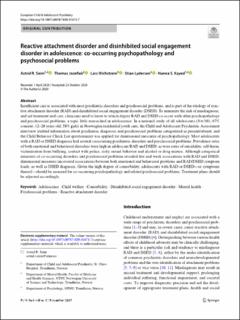| dc.description.abstract | Insufficient care is associated with most psychiatric disorders and psychosocial problems, and is part of the etiology of reactive attachment disorder (RAD) and disinhibited social engagement disorder (DSED). To minimize the risk of misdiagnosis, and aid treatment and care, clinicians need to know to which degree RAD and DSED co-occur with other psychopathology and psychosocial problems, a topic little researched in adolescence. In a national study of all adolescents (N = 381; 67% consent; 12–20 years old; 58% girls) in Norwegian residential youth care, the Child and Adolescent Psychiatric Assessment interview yielded information about psychiatric diagnoses and psychosocial problems categorized as present/absent, and the Child Behavior Check List questionnaire was applied for dimensional measures of psychopathology. Most adolescents with a RAD or DSED diagnosis had several cooccurring psychiatric disorders and psychosocial problems. Prevalence rates of both emotional and behavioral disorders were high in adolescent RAD and DSED, as were rates of suicidality, self-harm, victimization from bullying, contact with police, risky sexual behavior and alcohol or drug misuse. Although categorical measures of co-occurring disorders and psychosocial problems revealed few and weak associations with RAD and DSED, dimensional measures uncovered associations between both emotional and behavioral problems and RAD/DSED symptom loads, as well as DSED diagnosis. Given the high degree of comorbidity, adolescents with RAD or DSED—or symptoms thereof—should be assessed for co-occurring psychopathology and related psychosocial problems. Treatment plans should be adjusted accordingly. | en_US |

